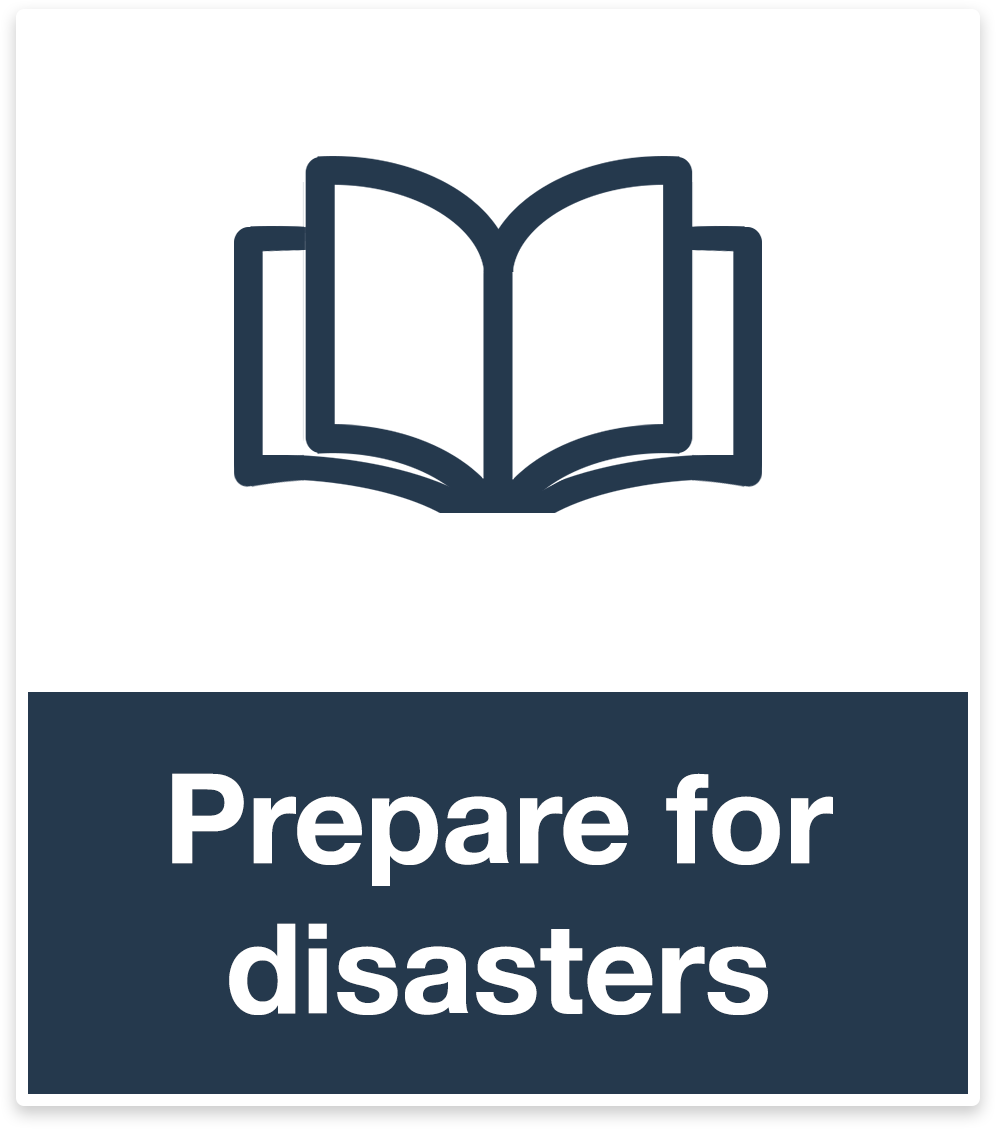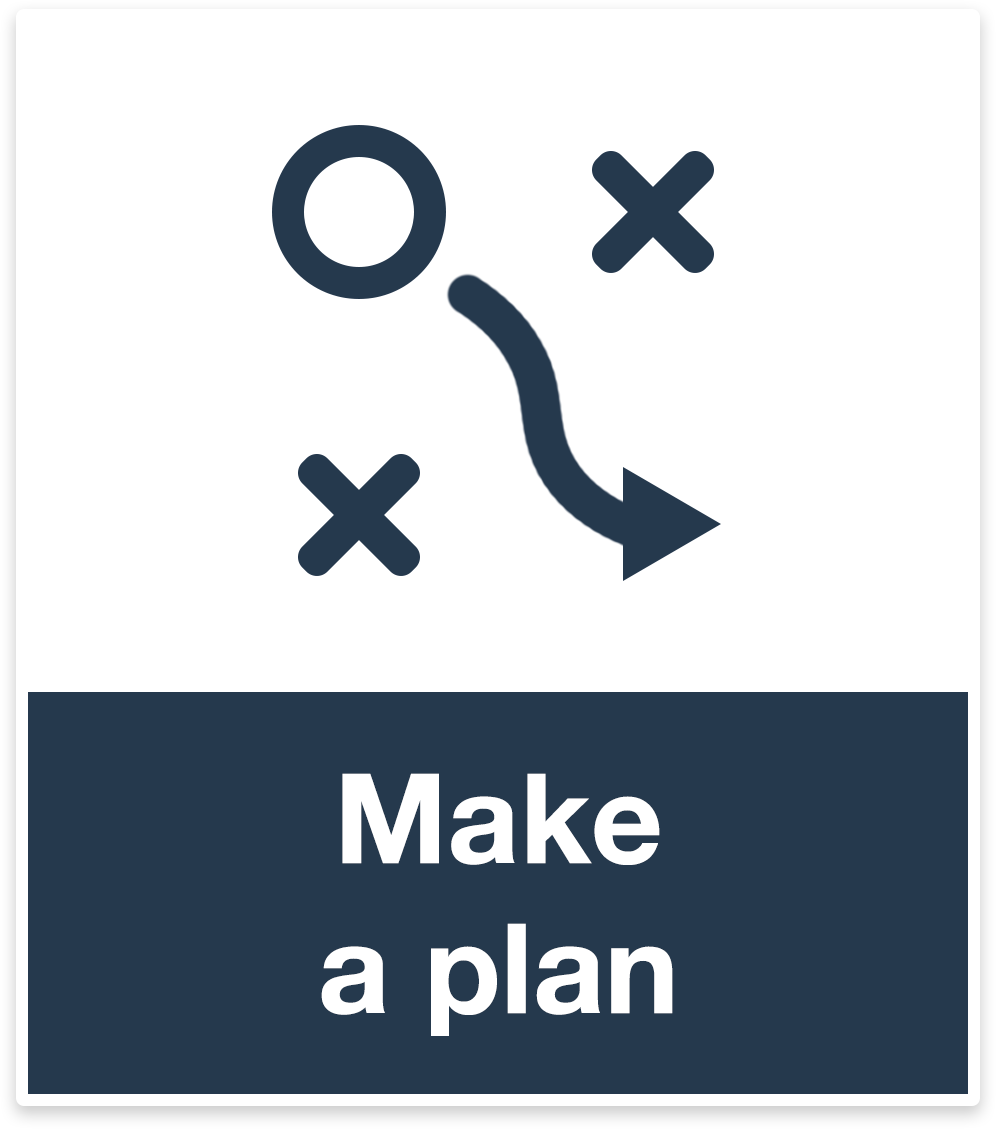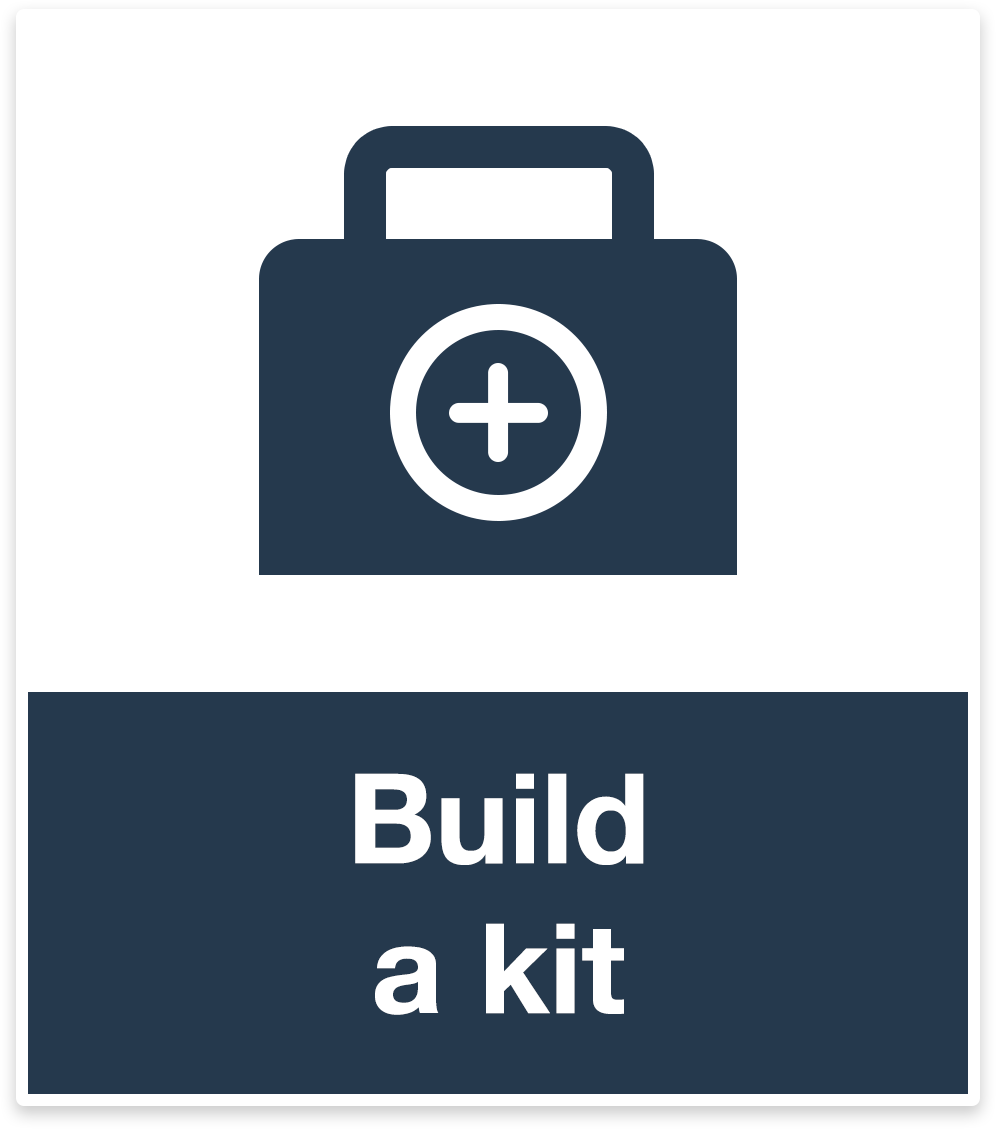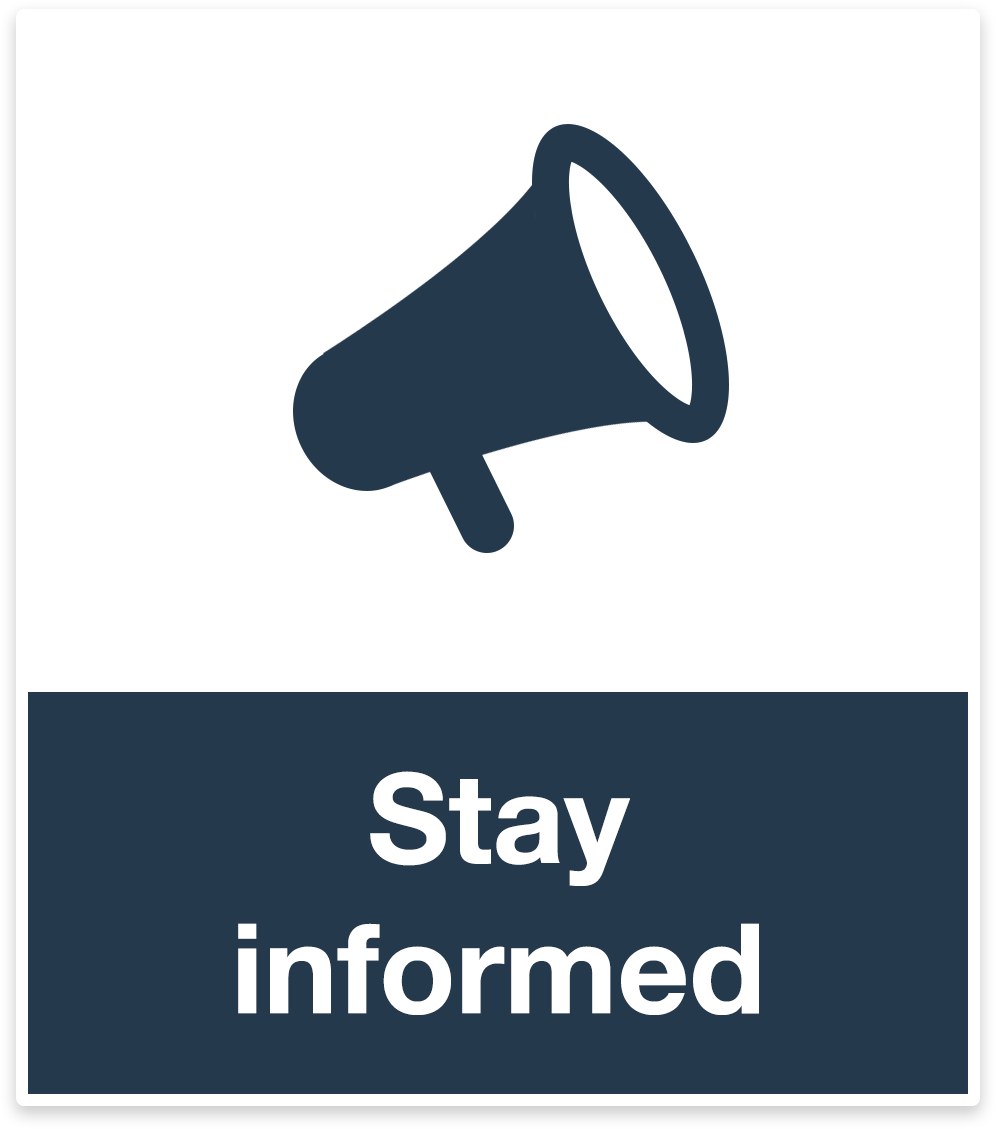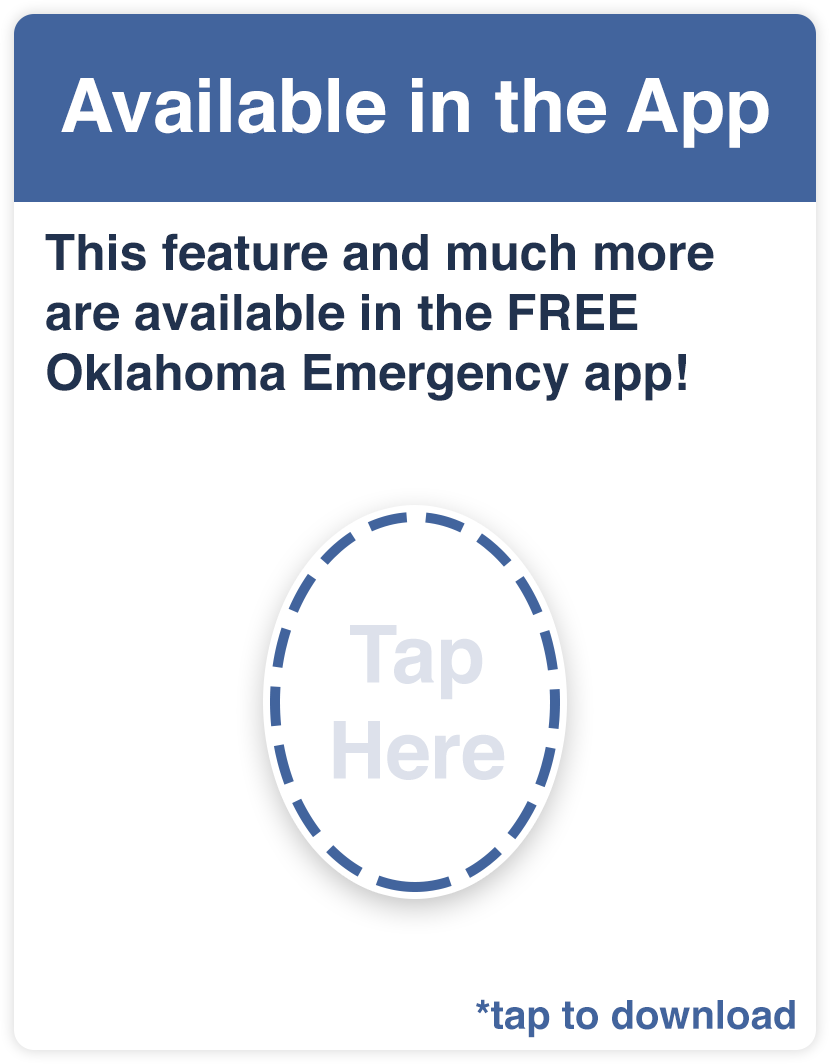
Select a Category:
Earthquake
Oklahoma has had an increased number of earthquakes in recent years, including the record-breaking 5.6 magnitude earthquake that occurred on November 6, 2011. To stay safe before,
during and after an earthquake, take the following precautions.
Before an Earthquake
- Prepare an emergency kit with at least a 72-hour supply of food and water, along with other supplies including a flashlight, portable battery-operated radio, batteries, medicines, first aid kit, money and clothing.
- Know the safe spots in each room-under study tables, desks, or against interior walls.
- Know the danger spots - near windows, mirrors, hanging objects, fireplaces and tall, unsecured furniture.
- Decide how and where your family will reunite if separated during a quake.
- Learn first aid and CPR.
During an Earthquake
- If you are indoors STAY THERE. Move away from windows, book cases, and high/overhanging shelves. Get under a sturdy table or desk and hold onto it. Be prepared to move with it and HOLD that position until the shaking stops and it is safe to relocate. If there is no desk or table to get under, brace yourself in an interior corner. Watch for falling, flying and sliding objects, and be especially careful around windows, as they can shatter during an earthquake.
- If you are outdoors, move to an open area away from buildings, trees, power poles, brick or block walls and other objects that could fall.
- If you are in an automobile, stop and stay in it until the shaking ends. Avoid stopping near trees and power lines or on or under overpasses or bridges.
- If you are in a multi-level building, get under a desk and hold on, or crouch next to an interior wall until the shaking stops. DO NOT USE THE ELEVATOR TO EVACUATE. Use the stairs.
- If you are in a store, get under a table or any sturdy object. Avoid stopping under anything that could fall. DO NOT RUN FOR THE EXIT.
After an Earthquake
- Put on heavy shoes immediately to avoid injury from stepping on glass.
- Locate a light source, such as a flashlight, if necessary.
- Check for injuries and administer first aid.
- Check for fires and fire hazards.
- Sniff for gas leaks, starting at the hot water heater. If you smell gas, hear a hissing sound or suspect a leak, turn off the main gas valve, open the windows and carefully leave the house. DO NOT TURN LIGHTS ON OR OFF. DO NOT STRIKE MATCHES.
- Do not shut off the gas unless you suspect a leak exists. Only the gas company can restore service.
- If necessary, turn off the electrical system at the main circuit breaker or fuse box.
- Check on your neighbors.
- Listen for advisories using a battery powered radio.
- Do not touch downed power lines or objects touching downed wires. Do not stand in water near downed lines.
- Remove fallen debris that may cause personal injury.
- Assess house, roof, and chimney for damages.
- Do not use the phone except in emergencies. only call 9-1-1 for life threatening emergencies. Have a plug-in analog phone in case the power is out, but phone lines are
- still working.
- For general and updated disaster information, call 2-1-1.
- Be prepared for aftershocks.
- Open closets and cupboards carefully because items may have fallen or become rearranged.
- Cooperate with public safety officials.
- Be prepared to evacuate when/if necessary.
- DO NOT GO SIGHTSEEING!
- If you are able, visit the USGS website and fill out a “Did you feel it?” form.
Floods are one of the most common and widespread of all natural disasters. Floods can be slow or fast rising and generally develop over a period of days. Flash floods usually result from intense storms dropping large amounts of rain within a brief period. Flash floods may occur with little or no warning and can reach full peak in only a few minutes.
Before the Flood
- Find out if you live in a flood-prone area.
- Plan and practice an evacuation route.
- Have disaster supplies on hand.
- Develop an emergency communications plan.
- Learn about the National Flood Insurance Program.
During the Flood
- Stay informed. Turn on a battery-operated radio or television to get the latest emergency information.
- If advised to evacuate, do so immediately.
- Avoid walking through floodwater. Water only six inches deep can sweep you off your feet if it is moving swiftly.
- Remember “Turn Around, Don’t Drown.” Do not drive into a flooded street. Cars can be swept away by two feet of moving water or there may be unseen damage to the road. If you come to a flooded area turn around and go another way. Most flood-related deaths are caused by people driving through water.
- Watch out for fire hazards.
After the Flood
- Take care of yourself first.
- Dry out your home.
- Restore the utilities.
- Clean up.
- Rebuild and flood proof.
- Prepare for the next flood.
Protect yourself from the next flood with flood insurance, a flood response plan and community flood protection programs.
If you are notified or become aware of a hazardous material emergency such as a chemical spill, chemical release, fire or explosion, do not panic.
If you are directed to evacuate, do so immediately
- Take your disaster supply kit and cellular phone.
- Lock your home.
- Cover your nose and mouth with a wet cloth.
- Travel on routes specified by local authorities.
- Head up-wind of the incident.
- If you have time, shut off your home’s water and electricity.
If instructed to stay inside (“shelter-in-place”) and not evacuate
- Close and lock windows and doors.
- Turn off ventilation systems and water.
- Seal gaps under doorways and windows with wet towels and duct tape.
- Listen to local television or radio for further instructions.
- Stay inside until you’ve been notified that it is safe to leave.
Emergency personnel are trained to respond to hazardous material emergencies. They will tell you what to do, either at the incident site or via television and radio.
Summer is the peak season for one of the nation's deadliest weather phenomena--lightning. Though lightning strikes peak in summer, people are struck year round. In the United States, an average of 51 people are killed each year by lightning, and hundreds more are severely injured. Your location when these strikes occur could greatly affect your chances of getting struck by lightning.
Lightning Safety
- NO PLACE outside is safe when thunderstorms are in the area.
- If you hear thunder, lightning is close enough to strike you.
- When you hear thunder, immediately move to safe shelter: a substantial building with electricity or plumbing or an enclosed, metal-topped vehicle with windows up.
- Stay in safe shelter at least 30 minutes after you hear the last sound of thunder.
Indoor Lightning Safety
- Stay off corded phones, computers and other electrical equipment that put you in direct contact with electricity.
- Avoid plumbing, including sinks, baths and faucets.
- Stay away from windows and doors, and stay off porches.
- Do not lie on concrete floors, and do not lean against concrete walls.
Last Resort Outdoor Risk Reduction Tips
If you are caught outside with no safe shelter anywhere nearby the following actions may reduce your risk:
- Immediately get off elevated areas such as hills, mountain ridges or peaks.
- Never lie flat on the ground.
- Never shelter under an isolated tree.
- Never use a cliff or rocky overhang for shelter.
- Immediately get out and away from ponds, lakes and other bodies of water.
- Stay away from objects that conduct electricity such as barbed wire fences, power lines, and windmills.
The best way to protect yourself is to plan ahead so you’re not caught outside when storms threaten. Be prepared to stop your outdoor work or recreational activity when storms approach.
A power outage refers to those times when regular electric service has been interrupted by damage to power lines or power stations. During a disaster situation, electric power can be
out for days or weeks. It is important to plan ahead for the possibility of losing electric power.
During a Power Outage
- During a power outage, monitor conditions using a battery-operated radio.
- Use the phone for life-threatening emergencies only.
- Call 9-1-1 for life-threatening emergencies. Call 2-1-1 for information about the emergency.
- Consider text messaging in non-life-threatening situations.
- Use flashlights for emergency lighting. Avoid using candles due to fire risk.
- Keep refrigerator and freezer doors closed to keep your food as fresh as possible.
- Turn off or disconnect appliances or electronics in use when the power goes out. Power may return with momentary "surges" or "spikes" that can damage computers and
- Never burn charcoal for heating or cooking indoors.
- Never use your oven as a source of heat.
- If the power may be out for a prolonged period, plan to go to another location (the home of a relative or friend, or a shelter).
- Eliminate unnecessary travel, especially by car. Traffic and railroad signal outages result in traffic congestion.
- Check your Emergency Supply Kit and replace or restock items as needed. Ensure that you have working flashlights and batteries.
- Store drinking water in clean plastic bottles and pots and pans.
- Maintain contact with friends and neighbors who may be more vulnerable.
- Check refrigerated food for spoilage. If in doubt, throw it out.
Generators
- Always use generators outdoors, away from doors, windows, and vents.
- Keep the generator dry.
- Dry your hands before touching the generator.
- Plug appliances directly into generator.
- Always use heavy duty extension cords that have all three prongs.
- Never connect a portable generator to house wiring.
- Turn off generator and allow to cool before refueling.
Public Health Emergencies include disease outbreaks, acts of bioterrorism, or natural disasters that can affect our food, drinking water, or air. The first evidence of an attack may be when
symptoms appear.
If You Are Exposed to a Suspicious Substance
- Move away quickly.
- Remove contaminated clothing.
- Wash with soap and water.
- Contact authorities.
- Listen for official information.
- Seek medical attention if you become sick.
Flu Outbreak
- Wash your hands often. This will help protect you and others against germs. When soap and water are not available, use alcohol-based disposable hand wash or gel
- When coughing or sneezing, cover your mouth and nose with a tissue. If you don't have a tissue, cough or sneeze into your sleeve or the inside of your elbow, not your
- Avoid close contact with people who are sick.
- If you are sick, stay home and away from other people, as much as possible to protect them from getting sick as well. Get plenty of rest and check with your doctor.
- Avoid smoking. Smoking may increase the risk of serious consequences if you get sick.
- Make a plan for someone to take care of children and people with access or functional needs if all adults in the household are sick.
Public Emergency Supplies
- Have two weeks’ worth of medical and health supplies on hand for you and your family, including:
- Soap or water free alcohol-based hand wash.
- Medicines for fever such as acetaminophen.
- Cough syrup.
- Fluids with electrolytes and other oral rehydration solutions.
- Oral rehydration solutions are used for people who have diarrhea, vomiting or fever. These solutions contain water and salts in specific proportions to replenish both fluids and electrolytes. Oral rehydration products are readily available in most drug stores.
- It is generally advised, to begin giving fluids early in the course of an illness instead of waiting until the situation becomes urgent.
- Prescription drugs: If you or a family member regularly takes prescription drugs, plan on having enough medicine on hand to last for several weeks.
Terrorist tactics continue to evolve and may include chemical, biological, radiological, nuclear and explosive weapons, and cyber attacks. Threats may come from abroad or be homegrown. Learn what actions to include in your family disaster plan to prepare for and respond to terrorist threats.
During an Attack
- If there is flying debris, drop down, take cover under something sturdy, and hold on to it with one hand while protecting your head and neck with the other.
- If there is smoke, get near the floor, cover your mouth and nose with a cloth, and move carefully towards the nearest marked exit.
- If it is necessary to evacuate, try to do so calmly. Never use elevators. Use only marked exit and stairways. Help others who are moving more slowly or who may be disoriented.
- If you are not directly affected by the attack, try to stay calm, think before you act, encourage others, and comfort children. Turn on news radio or television, and listen for official instructions. Follow the directions of authorities.
After an Attack
- Try to stay calm. Think before you act.
- Stay informed. Listen to official reports and instructions on the radio or television.
- If officials order an evacuation, cooperate quickly and follow their instructions regarding evacuation routes and shelter locations.
- If officials tell you to "Shelter in Place", they mean for you to stay inside your home, vehicle or workplace until it is safe to come out. Wait for additional instructions.
- Do not leave your sheltered location or return to the evacuated area until local officials confirm that it is safe to do so.
- Implement your family emergency plan, and notify your out-of-state contact of your location and status.
- Be aware of the psychological impact that terrorism can inflict, even when it happens to people you do not know personally.
A tornado is a rapidly rotating column of air extending to the ground from a thunderstorm cloud. The path width of a tornado is usually very narrow, but can range up to a half-mile or more in extreme cases. Tornadoes usually only last a few minutes, but a few can last for much longer, traveling along the ground for several miles. Tornadoes can remain almost stationary or can race across the countryside at speeds over 50 mph. Violent winds in and around the tornado can cause incredible destruction and can generate flying debris, which is the main cause of injuries in tornadoes.
Tornado Safety
Staying informed about weather conditions is the best way to avoid being caught in a tornado or severe thunderstorm. Your local National Weather Service Forecast Office provides information about dangerous weather in your area and you should keep a close eye on this information or local television stations whenever storms threaten your area. A battery operated NOAA Weather Radio with a warning alarm feature should be a part of your information system.
It’s also critical that you think about tornado safety long before there’s a storm on the horizon and plan what you will do to stay safe no matter where you may be when storms threaten.
Remember these basic guidelines:
GET IN - Get as far inside a strong building as you can, away from doors and windows.
GET DOWN - Get to the lowest floor.
COVER UP - Use whatever you can to protect yourself from flying or falling debris.
- A reinforced underground storm shelter, storm cellar, enclosed basement or safe room are usually the safest places in a tornado. Underground shelters get you out of the way of flying and falling debris, which is a tornado’s most dangerous weapon.
- If you cannot get underground, get as far inside the strongest building you can find. Stay away from doors, windows and other openings to the outside. Put as many walls between you and the outside as you can.
- Get as low as you can. Go to the lowest floor of the building you’re in.
- Cover up to protect yourself from flying and falling debris. Use whatever you can find - pillows, blankets, sleeping bags, mattresses. Wearing a helmet or hardhat will help protect your head from debris.
- Being outdoors, in a mobile home, or in a vehicle are all unsafe in a tornado or severe thunderstorm. Find stronger shelter before the storm arrives and remember to get in, get down and cover up.
Wildfires are dangerous and often caused by human activity. High winds and dry conditions can set the stage for potentially severe fires. The greatest single cause is when burning debris is not properly contained and sparks or burning trash blow into the air. Oklahomans can help prevent wildfires by taking the following precautions.
Prepare Your Home
- Follow all local building, fire and hazard abatement codes.
- Install non-flammable screens with mesh 1/4 inch or less on chimneys.
- Keep roofs and rain gutters free of needles, leaves or other debris.
- Enclose the underside of balconies and decks with fire resistant material, such as aluminum decking.
- Enclose all roof eaves with fire resistant material such as aluminum or steel and place 1/4 inch or less metal mesh over all attic or roof vents.
- Inspect and maintain chimneys and screens twice annually.
- Install a smoke detector on each level of your home, especially near bedrooms, and test them monthly.
Prepare Your Yard
- Clear the brush away from your home and keep the area lean, clean, and green.
- Trim all trees and tree branches away from electrical lines and chimneys. The use of a professional service to trim near utilities and power lines is recommended.
- Remove weak, dead, and leaning trees and bark beetle infested trees.
- Stack firewood at least 30 feet away from your home or other structures.
- Store all combustible or flammable liquids in approved storage containers
- Store all propane tanks at least 30 feet from any structure.
When Wildfire Approaches
- Listen to the radio or watch television for information and instructions from local officials.
- Don't wait to evacuate. Evacuate when danger is perceived or as soon as directed by public safety officials.
- When preparing to evacuate, park your vehicles facing the direction of escape with windows rolled up.
- Place your disaster kit along with valuables and other essentials in your vehicle.
- Secure pets and livestock and prepare them for evacuation.
- If time permits, cover up by wearing long pants, a long-sleeved shirt, goggles, cap, and bandanna.
- Close doors behind you when evacuating to slow down the flames, smoke, and heat.
- Help young children, seniors, and persons with access and functional needs to evacuate safely.
Emergency Access
- Ensure that your street name is clearly marked and posted.
- Ensure your house numbers are clearly visible both day and night from the street.
- Know at least two exit routes from your neighborhood in case of emergency.
- If possible, ensure that large emergency vehicles can access your property.
- Start or join a Community Emergency Response Team.
Winter weather in Oklahoma can bring extreme cold temperatures, snow and ice, and power outages. Always heed the warnings of law enforcement and transportation officials regarding road conditions and refrain from traveling when road conditions warrant. Stay safe by preparing your family, home, and vehicle for a winter storm.
Have a Plan
- Discuss with your family what to do if a winter storm watch or warning is issued.
- Ensure your family knows meeting places and phone numbers of other family members in case they are separated when a winter storm hits.
- Know what to do if basic services such as water, gas, electricity, or telephones are cut off for an extended period of time.
- Understand the hazards of wind chill. Cold temperatures are even more dangerous, and potentially deadly, when combined with strong winds. The lower the temperature and stronger the wind, the more at risk you are.
- Check on family, friends, and neighbors, especially the elderly. Make sure they are prepared.
- Plan to bring pets inside during winter weather. Move livestock to sheltered areas with non-frozen drinking water.
- Install and check smoke and carbon monoxide alarms.
- Let faucets drip to avoid freezing and know how to shut off water valves if necessary.
- Have an alternate heating method such as fireplace or wood or coal burning stove. Always be cautious using a portable space heater.
- Have your car winterized before winter storm season. Keep your gas tank full for emergency use and to keep the fuel line from freezing.
- Make sure your home is properly insulated. If necessary insulate walls and attic. Caulk and weather-strip doors and windowsills.
- Install storm windows or cover windows with plastic from the inside. Keep doors and curtain or blinds closed to keep heat in.
- To keep pipes from freezing, wrap them in insulation or layers of old newspapers. Cover the newspapers with plastic to keep out moisture.
- Never heat a home with an oven if the electricity goes out.
Make a Kit
Winter weather emergency kits require unique items including the following:
- Windshield scraper, de-icer, snow shovel and small broom for ice and snow removal.
- A cell phone with charger and a battery powered radio.
- Several blankets or sleeping bags.
- They are warmer than gloves because fingers generate warmth when they touch each other.
- Rain gear, warm coats and extra sets of dry clothing, mittens, socks and a cap.
- Non-perishable snacks like dried fruit, nuts and other high energy snacks.
- Several bottles of water. Eating snow will lower your body temperature. If necessary, melt it first.
- Sand or cat litter for generating traction under wheels and a set of tire chains or traction mats.
- Jumper cables, flashlight with extra batteries, first aid kit and brightly colored cloth to tie to antenna if you get stranded.
Stay Informed
- Know what National Weather Service winter storm and blizzard watches and warnings mean.
- A winter storm watch is a message indicating a winter storm is possible in your area.
- A winter storm warning indicates a winter storm is occurring winter storm is occurring or will soon occur in your area and could threaten life and property.
- A winter weather advisory means winter weather conditions are expected to cause significant inconveniences and may be hazardous, especially to motorists.
- A frost/freeze warning means below freezing temperatures are expected.
- Ice storms usually bring heavy accumulations of ice that can bring down trees, electrical wires, telephone poles and lines, and communication towers. Communications and power can be disrupted for days while the utility company works to repair the extensive damage.
- A blizzard warning means sustained winds or frequent gusts to 35 mph or greater and considerable falling or blowing snow is expected to prevail for a period of three hours or longer.
- Depend on your NOAA All Hazards Weather Radio, along with local radio and television stations, for weather reports.
Be Cautious with Alternative Heat Sources
Never use generators, grills, camp stoves or other gasoline or charcoal-burning devices inside your home or garage. They produce carbon monoxide which is an odorless, colorless and tasteless gas that kills more than 500 people every year. Use extra caution when using space heaters.
- Use fireplaces, wood stoves, or other combustion heaters only if they are properly vented.
- Do not place a space heater within 3 feet of anything that may catch on fire, such as drapes, furniture, or bedding, and never cover your space heater.
- Never place a space heater on top of furniture or near water.
- Never leave children unattended near a space heater.
- Do keep a multipurpose fire extinguisher on hand in case of emergency.
- Protect yourself from carbon monoxide poisoning by installing a battery-operated carbon monoxide detector and never using generators, grills, camp stoves or similar devices indoors.

Make a Plan
Contact
Recommendations:
Because it is often easier to call long distance during an emergency than within the affected area, choose an out-of-state friend or relative whom all family members will call if separated during an emergency. All family members should memorize this phone number.
Meeting Places
Recommendations:
Pick two meeting places where you and your family can meet after an emergency occurs-–one near your home and one outside your neighborhood in case you cannot return home after an emergency.
Utilities
Recommendations:
Know how to and where to shut off utilities. All adults in the family should know the location of the main water valve, main gas valve, garage door manual override and the location of any required tools.
Know how and where to shut off utilities. You and your family should know the location of main water valve, main gas valve, garage door manual override and the location of any required tools.
School Plans
Recommendations:
Learn the emergency plans at your children’s schools and make sure the school has your updated emergency contact information. Give written permission to a trusted friend or relative who can pick up your children from school or day care in case you cannot get there on time. Know how to best contact the school.
Preparation for Children
Recommendations:
Teach your children what to do in an emergency and make sure they know their own names and addresses, as well as the full names and contact information for parents and a second adult emergency contact.
Evacuation Plan
Recommendations:
Whether you are at home, at work, or in a public place, think of how you could leave quickly and safely. Locate stairwells and emergency exits. Pay attention to posted evacuation signs in buildings and crowded public areas. Never use elevators during an evacuation. If it is necessary to leave your home in advance of a tornado or severe storm, plan to leave well before the storm is threatening your town.
Identify Your Safest Place
Recommendations:
Before an emergency strikes, take time to identify your safest place at home and at work. Safe rooms, underground shelters, and basements are best, but if your house or building does not have one, choose a small, windowless interior room on the lowest level, such as a closet or bathroom. If you are in a mobile home, find shelter elsewhere.
Know Your Community's Outdoor Siren Warning System
Recommendations:
It is important to know whether you have outdoor warning sirens in your area and how they work. Check with your local emergency management, police, fire department, or sheriff’s office for information. Remember, sirens are an outdoor notification system and often can’t be heard indoors. If you hear a siren, seek shelter and find more information on TV or radio.
Practice
Recommendations:
At least once a year, have a meeting with your family to discuss and update your emergency plan. Determine what additional training, equipment, and supplies are needed. Practice your plan with drills to improve reaction time and help avoid panic during an actual emergency. Develop a schedule to practice your emergency plan.


Build a Kit
Replace food, water, and medications as necessary. Remember to consider household members with unique needs such as infants, elderly, individuals with access and functional needs, or those with allergies.
Basic Supplies
Water
Blankets or Sleeping Bags
Non-Perishable Foods
Portable Radio
First Aid Kit
Prescription and Over-the-Counter Medication
Sunscreen
Mess Kit
Flashlight
Fire Extinguisher
Money
Whistle
Important Documents
Dust Mask
Matches
Sanitation Supplies
Large Plastic Trash Bags
Bleach
Pre-moistened towelettes
Feminine Supplies
Infant Supplies
Hand Soap
Liquid Detergent
Toilet Paper and Paper Towels
Toothpaste
Safety Supplies
Heavy Gloves
Clothing
Heavy Shoes
Tools
Pet Supplies
Crate or Carrier
Collar with ID Tags
Food
Water (Pet)
Medications
Sanitation Items
Important Documents (Pet)
Personal Items
Games or Activities
Pillow
Stuffed Animal or Other Comfort Items






